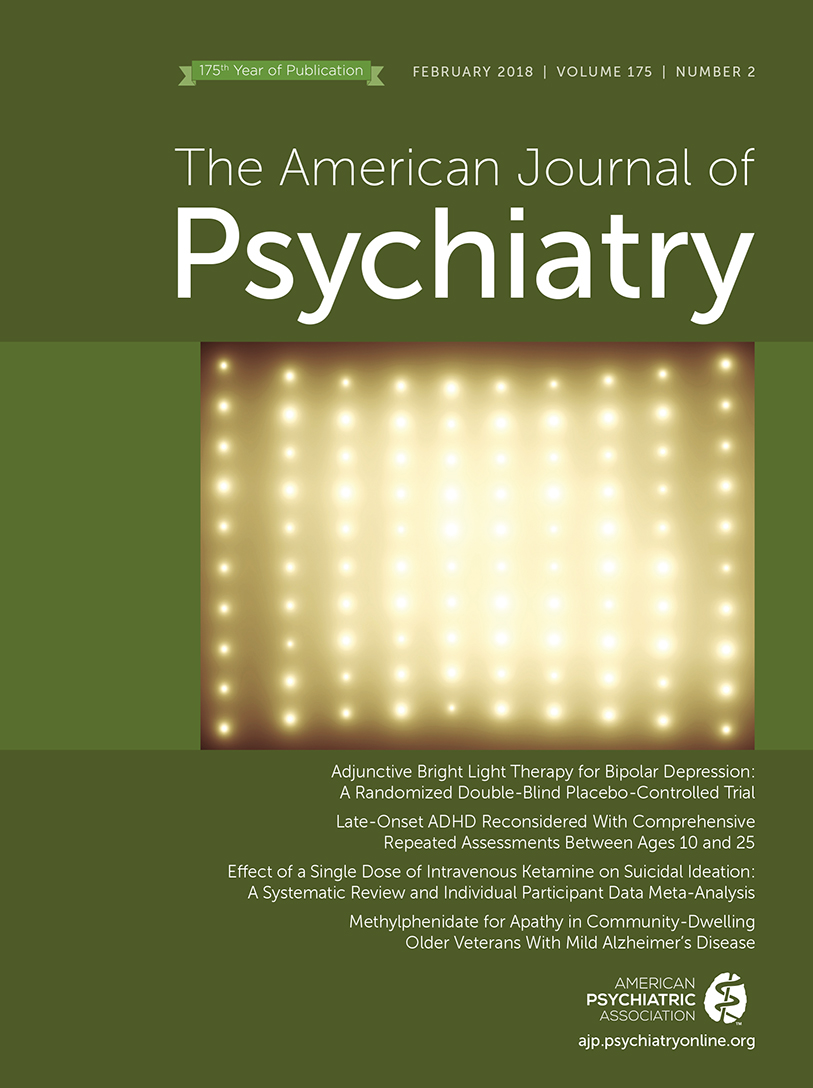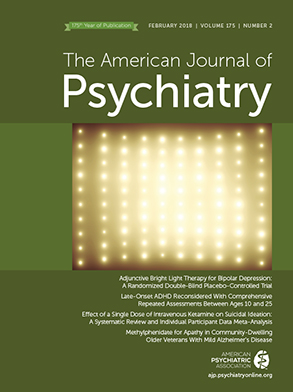In this issue, Robinson and colleagues (
1) provide an analysis of outcomes related to the medication prescribing component of the NAVIGATE treatment program, an integrated pharmacologic and psychosocial intervention for individuals in their first episode of psychosis. As reported previously in the
Journal (
2), the NAVIGATE program was compared with treatment as usual in the Recovery After an Initial Schizophrenia Episode–Early Treatment Program (RAISE-ETP) study (funded by the National Institute of Mental Health [NIMH]), and the results were quite positive. Individuals with first-episode nonaffective psychosis and less than 6 months of antipsychotic exposure were cluster-randomized by clinic and followed for 2 years. The 223 participants who were treated at 17 clinics that provided the NAVIGATE program exhibited superior outcomes on measures of quality of life, symptoms, and involvement in work or school compared with the 181 participants who were treated at 17 clinics that provided treatment as usual. Notably, benefits of the NAVIGATE program were observed only in individuals who had a shorter duration of untreated psychosis when outcomes were analyzed according to a median split (74 weeks) in baseline duration of untreated psychosis.
The focus of the present report from Robinson et al. is on the NAVIGATE approach to medication management, which included prescribing guidelines developed by the investigators, a computerized system (COMPASS) to support shared decision making by making treatment recommendations based on patient self-report of clinical status and side effects, and training and ongoing support for prescribers by Dr. Robinson and his team of experts. The authors found that the participants who were treated at NAVIGATE programs attended more medication visits, were more likely to receive an antipsychotic prescription, and were more likely to receive a prescription that conformed to the NAVIGATE treatment guidelines compared with individuals treated at clinics offering treatment as usual, including fewer prescriptions for antidepressants. Impressively, despite their more frequent acceptance of antipsychotics, individuals in the NAVIGATE programs reported fewer side effects and gained less weight during the 2-year study. In addition, participants treated at NAVIGATE programs expressed fewer negative beliefs about medication that might be associated with nonadherence.
On the face of it, this is a strong endorsement of the NAVIGATE prescribing program, particularly for individuals with a shorter duration of untreated psychosis. The pharmacologic approach of NAVIGATE emphasized frequent assessments that included structured self-report of side effects and treatment response and evidence-based recommendations to guide clinician response to this information based on computerized algorithms and expert consultation. The program was designed around principles of shared decision making, in which patients participate in treatment decisions and their preferences and values are considered. Although the study would have been strengthened by an assessment of fidelity to the COMPASS approach, Robinson and colleagues have demonstrated that implementation of this optimized pharmacologic approach is quite feasible.
Under the leadership of Dr. Robert Heinssen and his team at NIMH, the RAISE program has been remarkably successful in combining evidence-based treatments for first-episode psychosis into an integrated team-based package, establishing superior effectiveness compared with treatment as usual, and successfully disseminating this treatment model through federal legislative appropriation and a coordinated national program for training and technical support (
3). From a public health perspective, treatment packages are a highly efficient method for achieving maximal impact on clinical outcomes. There have been examples in other medical specialties in which packages of evidence-based treatments were found to be inferior to treatment as usual (
4,
5), demonstrating the importance of this level of clinical validation and the unpredictability of combining evidence-based treatments, particularly when translated to new treatment environments. While we can draw conclusions with confidence about the benefits of the entire NAVIGATE package, in the absence of “unbundling” studies in which individual components are examined individually or in which the package is examined minus individual components, it is difficult to attribute benefits to specific elements—in this case, the details of the prescribing algorithm. For example, the investigators emphasize that antidepressants were discouraged because depressive symptoms are known to resolve spontaneously in first-episode psychosis (
6). Prophylactic treatment with antidepressants has not been studied rigorously in first-episode psychosis, but antidepressants have been found in meta-analyses to improve negative symptoms and quality of life in patients with chronic illness (
7), and theoretical arguments have been made that antidepressants, via stimulation of brain-derived neurotrophic factor (BDNF) release, may exert a neuroprotective effect in early psychosis (
8). In other words, we must be careful not to interpret the success of a comprehensive treatment package as validation of individual components that have not individually been tested. Otherwise, we risk their permanent enshrinement within standard-of-care algorithms in which the service context bears little resemblance to the comprehensive treatment package within which they were tested. Similarly, because the psychosocial elements of the NAVIGATE treatment model include modules on medication education, adherence, and health-promoting behaviors (
9), benefits such as improved treatment acceptance and reduced weight gain cannot be attributed solely to the pharmacologic management program without acknowledging the contributions of other NAVIGATE components.
An additional lesson from the RAISE-ETP study follows from the finding that half of participants with a longer duration of untreated psychosis did not benefit from enhanced pharmacological and psychosocial treatment. In the absence of informative biomarkers or methods for subgroup categorization, our treatment algorithms have been developed based on the average response derived from highly heterogeneous samples of individuals with schizophrenia. A substantial number of patients may fall outside the confines of these treatment algorithms—perhaps potentially benefiting from higher or lower dosing, different adjunctive pharmacologic agents, or different psychosocial approaches compared with the “average” patient for whom standard algorithms best apply. The astute observation by the NAVIGATE team that their intervention did not benefit individuals with a longer duration of untreated psychosis should serve as a call to examine this subgroup for clues that might lead to alternative pharmacologic and psychosocial interventions and the development of treatment algorithms that reflect an individualized or precision medicine approach.

